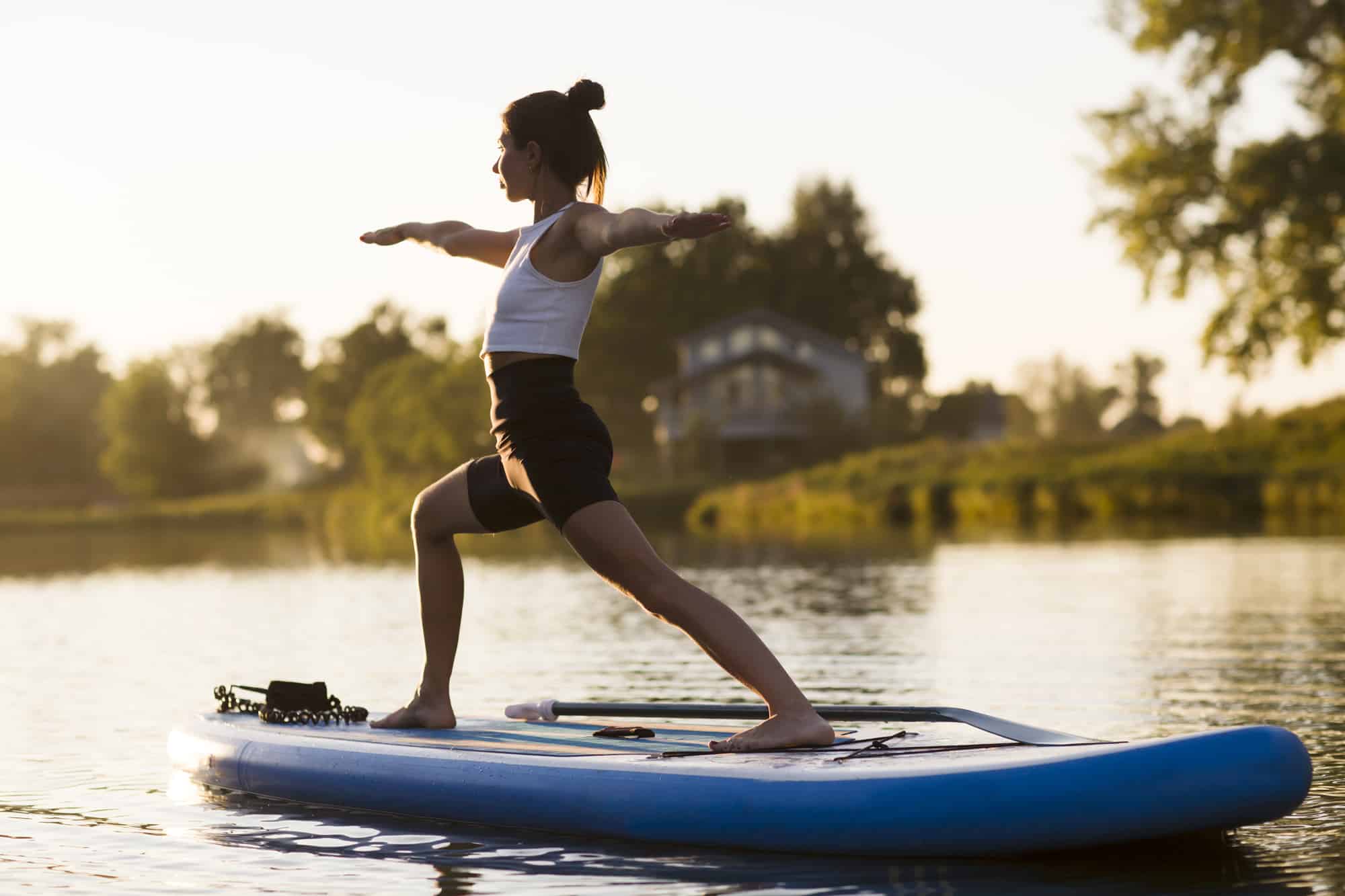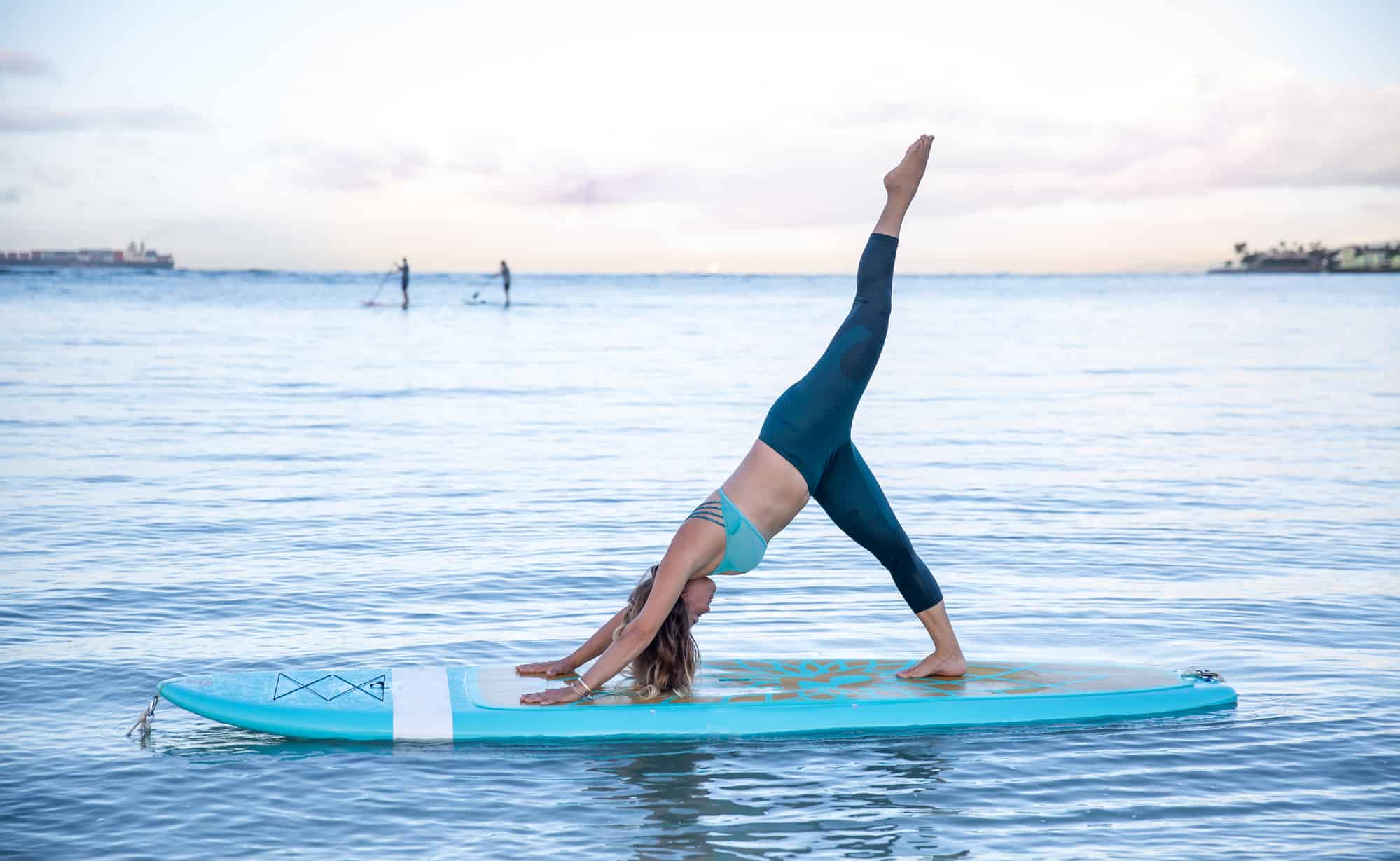What Does Sup Yoga Mean?
SUP yoga is a brand-new yoga type that gains popularity and gives you the most stunning photos for your Instagram.
Apart from that, paddleboard yoga makes your body work, grow muscles, and gain more stability. In addition, because SUP yoga on the water involves more balancing, you can train muscles that are not active while you are standing on the ground.
Below we’ll go through the following points to provide you with a complete guide for paddleboard yoga:
- How do you do SUP yoga?
- Why You Should Try SUP Yoga
- How To Get Your Paddle Board Ready for Yoga
- Beginner’s Tips & Tricks for SUP Yoga
- 5 SUP Yoga Poses You Can Try Today
So if you’re new to SUP yoga, you’ll get a set of 5 basic exercises you can start with. But if you already love to do yoga on the ground, you can spice your practice with some paddleboard yoga asanas. Whether you are looking to dive deeper into the practice or burn calories ¬ ¬– SUP yoga has something for you.
How Do You Do Sup Yoga?
SUP yoga contains a range of traditional yoga poses that are done on a paddleboard on a water surface. But it has some differences from land yoga. So here are a few adjustments you should know about before starting SUP yoga practice.

Make changes in your yoga sequences: when you do SUP yoga, you are likely to include both Hatha and Flow yoga poses into it. Hatha yoga is usually slower than flow yoga. Hatha yoga exercises work well on the paddleboard and are easier to perform than Flow yoga. Depending on your previous land yoga routine, this may take some time to get used to the poses changes.
Ensure your balancing skills are suitable: You will need more focus and balance for SUP yoga, especially if you are new to it. In addition, it’s necessary to find harmony between wind, waves, and small space for your feet.
Enjoy nature: one of the critical differences in SUP yoga is that you do it in the open air, so you can enjoy smells and soothing sights, calming water views, and sounds. This yoga type provides you with more sensory information and helps to dive deeper into the practice. Such things aren’t available in the yoga studio.
Why You Should Try SUP Yoga?
There are various reasons to try SUP yoga, here are only a few of them:
First, enhance your mindfulness: concentrating makes you even more present during the SUP yoga session.
Get your muscles trained in a new way: SUP yoga involves different muscle groups compared with land yoga. It will challenge your core, back, legs, and arms muscles in new ways and allow you to develop flexibility and focus.
Diversify your yoga skills: SUP yoga brings you a new yoga training experience. You see that you will be using your core and leg muscles more, trying not to fall off the paddleboard.
Find new inspiration to practice yoga: SUP yoga is a new challenge for the body and mind that refreshes your yoga skill. As far as you master this type of yoga, you’ll become more confident and healthy.

How To Get Your Paddle Board Ready for Yoga?
To be safe during the SUP yoga practice, you should equip your paddleboard properly. For this, you’ll need:
- Tethers and anchor. An adequately anchored board will keep you in place during the practice. Not all like to be floating when they exercise.
- A personal flotation device(PFD) guarantees you safety on the water. Getting a compact PFD is another security measure.
- An emergency whistle will help you call for help in case of an emergency.
- Dry bad is used to store your belongings while you do SUP yoga.
- Straps and bungees will help you hold the water bottle, the board, or other things you would like to have with you.
Beginner’s Tips for SUP Yoga
If you’ve never done paddleboard yoga before, the below tips will help you make a comfortable start in it:
Find a protected spot: Wind or waves can make your starting session a disaster. So paddle to a place that is protected from the strong blowing wind.
Stay away from the crowd: People usually like to stare at someone doing SUP yoga, but if you don’t want to be the center of their attention, find a distant place with fewer people around.
Move slowly: Unlike in land yoga, you should move very slowly on the paddleboard.
The wide stance is a rule: it’s more preferable to keep your legs hip-width apart in SUP yoga for better stability in the poses.

Stick to two points of contact: One-leg standing poses like Tree pose or Eagle pose are considered challenging for paddleboard yoga. That’s why we recommend trying first poses with both soles on the board. Also, perpendicular positions are more stable on water paddleboards than those requiring your body to be parallel with the board.
Let go of the excess control: SUP yoga is a less controlled practice than land yoga you used to do. Always there is a possibility to fall off the board out of a sudden. Don’t judge yourself and recognize that everything can happen, and enjoy the practice.
5 SUP Yoga Poses You Can Try Today
Cobra Pose (Bhujangasana)
Cobra is known as a cool backbend. Lie down on your belly, put palms under your shoulders. As you inhale, lift the upper body firmly, pull your shoulder down, and open your chest. You can hold the pose in static or make dynamic moves. But remember to do it slowly without jerks.
Camel Pose (Ustrasana)
Stand on your knees hip-width apart. Gently grab your heels with both hands and push the ribcage up.
Camel pose is known for strengthening your back and stretching the front of your body.
Pigeon Pose (Eka Pada Rajakapotasana)
The pigeon pose is an incredible hip opener and provides a sense of calm. Take great care that you don’t feel any pain or pressure on your knees during this pose, and if it feels uncomfortable, stop and ask a yoga instructor for help.
Chair Pose (Utkatasana)
Most yogis dread chair pose (hello, burning thighs), but you’ll certainly feel good when it’s over! It’s excellent for strengthening your quads.
Corpse Pose (Shavasana)
This relaxing, healing pose is usually done as the last step in a yoga class. You’ll feel calm throughout your body and may experience a meditative effect. Some people consider Savasana their favorite part of yoga class, and once you try it, you’ll see why.
SUP Yoga FAQs
Who started SUP yoga?
One of the founders is Rachel Bråthén.
Can you do yoga on an inflatable paddle board?
Yes. Inflatable SUPs are good for paddle borad yoga as well, but they offer a more intense training. Although its surface is softer.
What type of paddle board is best for yoga?
Hard SUP Board for Yoga is the best paddle to choose.